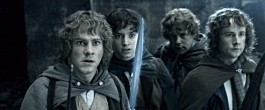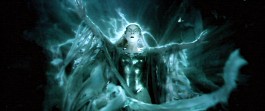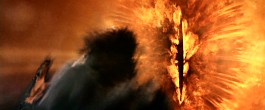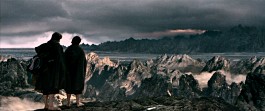The Lord of the Rings: The Fellowship of the Ring appears in an aspect ratio of approximately 2.35:1 on this single-sided, dual-layered DVD; the image has been enhanced for 16X9 televisions. Overall, the picture seemed solid, with very few flaws on display.
Sharpness appeared excellent. The movie always remained nicely crisp and distinct, and I noticed virtually no instances of softness or fuzziness. Jagged edges and moiré effects created no concerns, and I also detected no signs of edge enhancement. As for print flaws, the movie showed a wee smidgen of grain at times, but this remained very minor. Otherwise, the image seemed free of any form of defects.
 Fellowship enjoyed a stylized palette that varied dependent on the location. For example, when we entered elf territory, the film adopted a more golden tone. The colors always remained nicely vivid and vibrant, and they showed no problems related to bleeding, noise, or other concerns, even when we entered some red-dominated areas. Black levels came across as deep and dense, while shadow detail was appropriately heavy but not overly thick. Ultimately, the image of Fellowship looked pretty terrific.
Fellowship enjoyed a stylized palette that varied dependent on the location. For example, when we entered elf territory, the film adopted a more golden tone. The colors always remained nicely vivid and vibrant, and they showed no problems related to bleeding, noise, or other concerns, even when we entered some red-dominated areas. Black levels came across as deep and dense, while shadow detail was appropriately heavy but not overly thick. Ultimately, the image of Fellowship looked pretty terrific.
I also felt pleased with the Dolby Digital 5.1 EX soundtrack of Fellowship, though I admit it didn’t overwhelm me to the degree apparently experienced by others. I’ve read massive praise for the mix that I don’t think it merits. Actually, the audio did overwhelm me, which was the problem. Bass levels went off the chart during much of the film, and I don’t feel that more is necessarily better. Fellowship poured on the low-end to an excessive degree, and it became a distraction at times. It seemed like every little noise pounded my subwoofer into submission, and this felt over the top and unnecessary. Some may love this emphasis on heavy bass, but it dissatisfied me to a small degree.
Otherwise, Fellowship provided a very solid auditory experience. The soundfield offered a very wide and engaging piece. All five channels received active usage throughout the film, and they created a nicely vivid and life-like environment. Music showed fine stereo presence, while effects appeared from all around the spectrum. Those elements blended together neatly, and they moved cleanly from speaker to speaker. Surround usage was effective and accurate without becoming overwhelming or gimmicky. None of the film’s scenes stood out to me as anything particularly noteworthy, but the package mixed together to become a fine and seamless whole.
 Except for the heavy bass, audio quality seemed strong. Dialogue sounded natural and crisp, and I noticed no problems related to edginess or intelligibility. Music was bright and vibrant and displayed positive range; the excessive low-end became an issue only in regard to effects. Other than that factor, those elements appeared clean and distinct, and they lacked any signs of distortion. The overwhelming bass almost caused me to knock my grade down to a “B+”, but I felt the overall audio of Fellowship worked well enough to merit an “A-“.
Except for the heavy bass, audio quality seemed strong. Dialogue sounded natural and crisp, and I noticed no problems related to edginess or intelligibility. Music was bright and vibrant and displayed positive range; the excessive low-end became an issue only in regard to effects. Other than that factor, those elements appeared clean and distinct, and they lacked any signs of distortion. The overwhelming bass almost caused me to knock my grade down to a “B+”, but I felt the overall audio of Fellowship worked well enough to merit an “A-“.
Three months after this initial DVD release of The Fellowship of the Ring, New Line will produce a super-special edition that packs hours and hours of extras. Because of that, this two-disc set seems destined to become regarded as the “bare bones” version. However, that interpretation would seem very incorrect. While this package doesn’t include nearly as much material as the subsequent one, it still offers a lot of goodies.
All of these appear on DVD Two; this version of Fellowship
doesn't
provide an audio commentary or anything else on the first platter. We
start
with a series of promotional documentaries. An in-store special
created by
book publishers Houghton Mifflin, Welcome to Middle-earth
In-Store
Special runs 16 minutes and 44 seconds. It mixes many film clips with
some
behind the scenes shots and a series of interviews. In the latter
category,
we hear from publisher Rayner Unwin, director Peter Jackson, author of
"The Lord of the Rings Official Movie Guide" Brian Sibley,
conceptual
artist Alan Lee, Houghton Mifflin Director of Tolkien Projects Clay
Harper,
WETA Workshop President Richard Taylor, and actors Cate Blanchett, Ian
McKellen, Orlando Bloom, Elijah Wood, and Viggo Mortensen.
 Probably the best of the DVD's documentaries, "Welcome" is also the
shortest
and the most promotional; it touts Fellowship as "the most
anticipated film of all time", which is a crock. However, it includes
some
good shots from the set, and the chat with Unwin provides some
wonderful
information. He was involved with the original publication of the
Rings series and he adds great notes about its early days.
Heck, he
even possesses a name that sounds like a Rings character!
Probably the best of the DVD's documentaries, "Welcome" is also the
shortest
and the most promotional; it touts Fellowship as "the most
anticipated film of all time", which is a crock. However, it includes
some
good shots from the set, and the chat with Unwin provides some
wonderful
information. He was involved with the original publication of the
Rings series and he adds great notes about its early days.
Heck, he
even possesses a name that sounds like a Rings character!
Next we find Quest for the Ring, a special that ran on Fox TV. It lasts 21 minutes and 26 seconds and includes the same combination of movie scenes, behind the scenes material, and interviews. In this one, we hear from director Jackson, WETA President Taylor, producer Barrie Osborne, and actors Blanchett, Wood, Liv Tyler, McKellen, Mortensen, Sean Astin, Billy Boyd, Dominic Monaghan, Bloom, John Rhys-Davies, Christopher Lee, and Sean Bean.
Another heavily promotional piece, “Quest” fails to include as much substance as “Welcome”. Again, we find some good shots from the set, but the overall tone seems superficial. Much of the piece simply explains the story and the characters, and it includes little insight into the production. Too many movie scenes show up as well. It still provides some decent shots, but most of these appear elsewhere, so “Quest” feels fairly superfluous.
Moderately better is A Passage to Middle-earth, which ran on the Sci-Fi Channel. At 41 minutes and 36 seconds, “Passage” provides the longest of the disc’s programs, and it also uses the same format as the others. For the interview segments, we get comments from director Jackson, WETA President Taylor, producer Osborne, production designer Grant Major, ring creator Thorkild Hansen, co-writer Philippa Boyens, propmaster Nick Weir, swordmaster Bob Anderson, conceptual designer Alan Lee, casting Liz Mullane, costume designer Ngila Dickson, dialect coaches Andrew Jack and Roisin Carty, supervising art director Dan Hennah, special effects creator Greg Butler, assistant swordmaster Kirk Maxwell, chainmailer Chris Smith, director of photography Andrew Lesnie, conceptual designer John Howe, and actors Blanchett, Wood, Lee, Bloom, McKellen, Astin, Boyd, Mortensen, Tyler, Hugo Weaving, Rhys-Davies, and Monaghan.
 That’s the most extensive roster of the set, and “Passage” offers the most detailed experience. I prefer “Welcome” due to its unique materials, but “Passage” provides a decent piece. Actually, it feels a lot like a longer version of “Quest”, as it also includes many scenes from the movie and a fairly generic promotional tone. However, it tosses in more of a focus on the behind the scenes material, and we learn some good notes about the film. There’s less emphasis on cast and story and more of a concentration on production design, the different races, and other elements. Overall, “Passage” seems like a fairly good little show.
That’s the most extensive roster of the set, and “Passage” offers the most detailed experience. I prefer “Welcome” due to its unique materials, but “Passage” provides a decent piece. Actually, it feels a lot like a longer version of “Quest”, as it also includes many scenes from the movie and a fairly generic promotional tone. However, it tosses in more of a focus on the behind the scenes material, and we learn some good notes about the film. There’s less emphasis on cast and story and more of a concentration on production design, the different races, and other elements. Overall, “Passage” seems like a fairly good little show.
Next we encounter 15 different featurettes that originally appeared on Lordoftherings.net. These segments run between 96 seconds and four minutes, 34 seconds for a total of 38 minutes and 54 seconds of material. The programs concentrate mainly on behind the scenes shots, with some interview clips also tossed in for good measure. We hear from director Jackson, conceptual designers Lee and Howe, local farmer Ian Anderson, costume designer Dickson, supervising art director Hennah, production designer Major, producer Osborne, director of photography Lesnie, special physical effects technician Darryl Richards, dialect coach Carty, Harper Collins Ltd.’s Jane Johnson, composer Howard Shore, WETA President Taylor, and actors McKellen, Astin, Wood, Tyler, Mortensen, Boyd, Bloom, Monaghan, Lee, and Blanchett.
Six of the featurettes focus on specific actors; we get segments on Wood, Mortensen, Bloom, Blanchett, Tyler and McKellen. The other nine look at different elements of the production; from locations to effects to music, we learn about a nice mix of subjects. The package lacks great depth but if provides a nice “you are there” tone that makes the clips interesting. They don’t substitute for a rich documentary, but they seem enjoyable.
 The rest of the extras follow a very promotional line. We get three trailers, all of which appear anamorphic with Dolby Digital 5.1 sound. In addition, six TV Spots appear, as does a music video for “May It Be” by Enya. This is a very standard song-from-a-movie video. It mixes lip-synch shots of Enya with many shots from the film. Both the song and the video seem exceedingly dull.
The rest of the extras follow a very promotional line. We get three trailers, all of which appear anamorphic with Dolby Digital 5.1 sound. In addition, six TV Spots appear, as does a music video for “May It Be” by Enya. This is a very standard song-from-a-movie video. It mixes lip-synch shots of Enya with many shots from the film. Both the song and the video seem exceedingly dull.
Fellowship fans may hate the Special Extended DVD Edition Preview, since it may make their wait for that package seem even longer. Actually, I doubt the 184-second piece will frustrate too many. It quickly discusses the additions to the film and the package’s supplements, so it’s a nice appetizer but nothing terribly compelling.
Even more enticing for fans is the Behind the Scenes Preview of The Two Towers. Scheduled to come out in mid-December 2002, this 10-minute and 42-second program mixes scenes from that film with some interviews. We get notes from director Jackson, producer Osborne, executive producer Mark Ordesky, WETA President Taylor, and actors Wood, Boyd, Monaghan, Miranda Otto, Andy Serkis, Bloom, Mortensen, and Astin. We hear about the movie’s basic plot and learn of some distinctions, including new actors. We also see a little of the creation of some visual effects like Gollum.
Yet another promotional preview touts the Two Towers Video Game. In this 181-second clip, we hear from game producers/co-directors Scott Evans and Hudson Piehl as they tell us about it and relate what they wanted to do with it. We also see some images from the product.
 Lastly, Fellowship features some DVD-ROM materials. We find two different weblinks. One goes to the official movie website at Lordoftherings.net, while the other provides “exclusive online content”. The latter doesn’t give us much right now. As of a week after street date, it offers computer wallpaper, a screensaver, and e-cards. The site promises additional pieces in the future, however.
Lastly, Fellowship features some DVD-ROM materials. We find two different weblinks. One goes to the official movie website at Lordoftherings.net, while the other provides “exclusive online content”. The latter doesn’t give us much right now. As of a week after street date, it offers computer wallpaper, a screensaver, and e-cards. The site promises additional pieces in the future, however.
Fans had high expectations for The Lord of the Rings: The Fellowship of the Ring, and the film seems to match them. As a neophyte to the realm, I feel the movie has some minor flaws, but overall it comes across quite well, and it offers an exciting and rich experience. The DVD offers very good picture and sound - despite some excessive bass - and tosses in a moderately superficial but still solid roster of extras. Fellowship comes with my recommendation.
Note: as I mentioned earlier, New Line will produce a much more elaborate DVD package of Fellowship three months after the release of this two-disc set. That version will include a substantially longer cut of the film as well as tons of extras not found here. From what I understand, virtually none of this package’s supplements will also appear on the “deluxe” set. In addition, this one will offer the only way to see the original theatrical version of the film.



